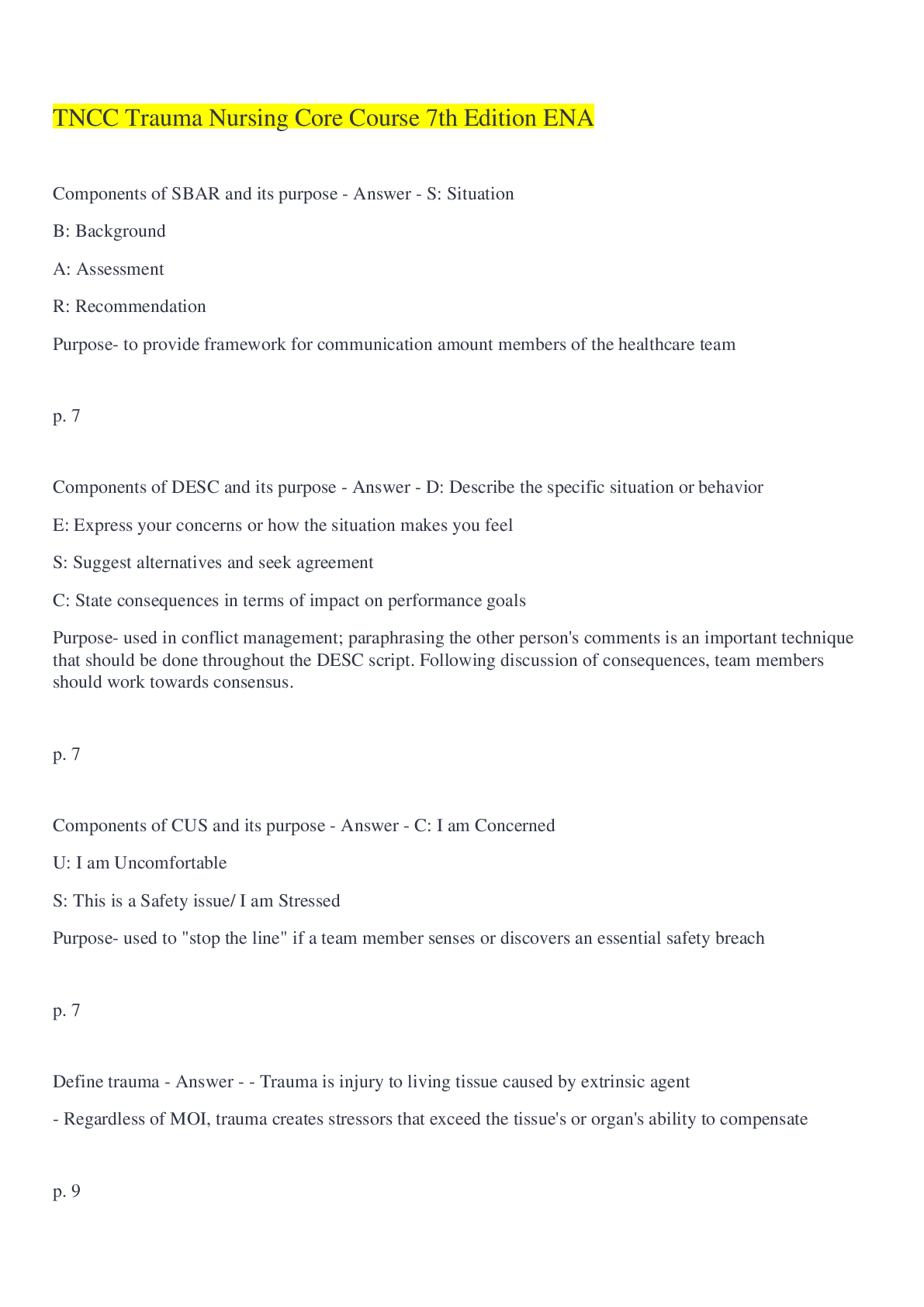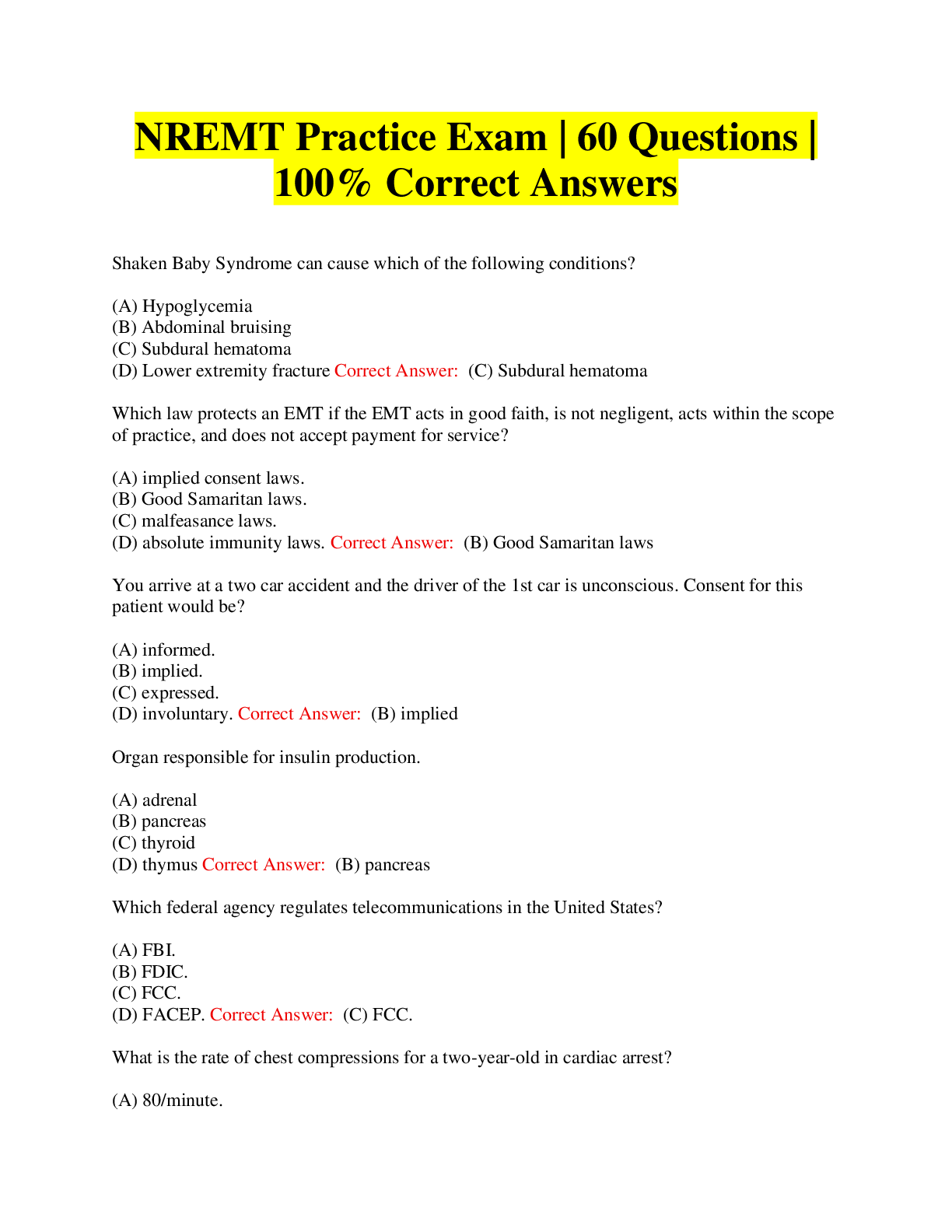Health Care > EXAM > TNCC Trauma Nursing Core Course 7th Edition ENA QUESTIONS AND ANSWERS 100% CORRECT (All)
TNCC Trauma Nursing Core Course 7th Edition ENA QUESTIONS AND ANSWERS 100% CORRECT
Document Content and Description Below
TNCC Trauma Nursing Core Course 7th Edition ENA Components of SBAR and its purpose Correct Answer: S: Situation B: Background A: Assessment R: Recommendation Purpose- to provide framework for ... communication amount members of the healthcare team p. 7 Components of DESC and its purpose Correct Answer: D: Describe the specific situation or behavior E: Express your concerns or how the situation makes you feel S: Suggest alternatives and seek agreement C: State consequences in terms of impact on performance goals Purpose- used in conflict management; paraphrasing the other person's comments is an important technique that should be done throughout the DESC script. Following discussion of consequences, team members should work towards consensus. p. 7 Components of CUS and its purpose Correct Answer: C: I am Concerned U: I am Uncomfortable S: This is a Safety issue/ I am Stressed Purpose- used to "stop the line" if a team member senses or discovers an essential safety breach p. 7 Define trauma Correct Answer: - Trauma is injury to living tissue caused by extrinsic agent - Regardless of MOI, trauma creates stressors that exceed the tissue's or organ's ability to compensate p. 9 Leading cause of death for ages 1. over 65 2. 5 to 24 3. 25 to 64 Correct Answer: 1. Falls 2. MVCs 3. poisoning p. 9 Explain 3 phases of injury prevention Correct Answer: Primary: prevention of the occurrence of the injury Secondary: Reduction in the severity of the injury that has occurred Tertiary: Improvement of outcomes related to the traumatic injury p. 10 Describe the three E's of injury control Correct Answer: Engineering: technological interventions such as side impact airbags, automated blind spot alarms, ignition lock devices for those with DUIs. In playgrounds and sports, this involves surface material under playground equipment and athletic safety gear. Another intervention is improved use of smoke alarms in fire prevention Enforcement and legislation: include laws at all jurisdictional levels regarding driving while intoxicated, booster seats, primary seatbelt use, and distracted driving. For sports this includes rules regarding illegal hits, examination after impact, and return-to-play requirements after a head injury Education: these can be community-based initiatives such as public service announcements for improved seatbelt use, education regarding risks of distracted driving, programs to commit to no texting while driving, and promotions for bicycle helmet giveaways with instructions for proper use p. 11 How can the trauma nurse have an impact when it comes to the legislative process? Correct Answer: By advocating for stronger laws and more consistent enforcement p. 11 Define kinematics Correct Answer: The study of energy transfer as it applies to identifying actual or intentional injuries p. 25 Define biomechanics Correct Answer: The general study of forces and their effects p. 25 Define mechanism of injury (MOI) Correct Answer: How external energy forces in the environment are transferred to the body p. 25 Newton's First Law of Motion Correct Answer: A body at rest will remain at rest, and a body in motion will stay in motion p. 26 Newton's Second Law of Motion Correct Answer: Force = Mass X Acceleration p. 26 Newton's Third Law of Motion Correct Answer: For every action, there is an equal and opposite reaction p. 26 Law of Conservation of Energy Correct Answer: Energy can neither be created nor destroyed, but it can change form p. 26 Describe energy forms Correct Answer: - Mechanical (energy transfer from one object to another in the form of motion) - Thermal (energy transfer of heat in environment to the host) - Chemical (heat energy transfer from active chemical substances such as chlorine, drain cleaner, acids, or plants) - Electrical (energy transfer from light socket, power lines, or lightning) - Radiant (energy transfer from blast sound waves, radioactivity such as a nuclear facility, or rays of the sun) p. 26 External energy forces can be exerted on the body by the following forces Correct Answer: - Deceleration forces: include those applied in falls and collisions where injuries are caused by sudden stop of the body's motion - Acceleration forces: not as common as deceleration forces and result from a sudden and rapid onset of motion (parked car being hit by a vehicle traveling at a high rate of speed) - Compression force is an external force applied at times of impact, explains include: + Stationary objects such as dashboards or steering wheels, that collide with or push up into a person + Objects in motion such as bullets and stabbing instruments, bats and balls, fists and feet, or heavy falling objects + Blast forces p. 27 The degree to which tissues resist destruction under circumstances of energy transfer depends on... Correct Answer: Their proximity to the impact and their structural characteristics p. 27 Structural strengths of tissue are described in what three ways? Correct Answer: -Compression -Tensile -Shear p. 27 Compression strength refers to the tissue's ability to: Correct Answer: Resist crush force - Compression injuries to organs occur when the organs are crushed from surrounding internal organs or structures such as a seatbelt worn up across the abdomen causing compression of the small bowel or a fracture to the lumbar spine p. 27 Tensile strength describes the tissue's ability to: Correct Answer: Resist pulling apart when stretched - Tendons, ligaments, and muscles can tear when they are overstretched (Achilles tendon) p. 27 Shear strength describes the tissue's ability to: Correct Answer: Resist a force applied parallel to the tissue - Coup/contrecoup injury, such as a boxer being hit in the head, is an example of this p. 27 Types of injuries include Correct Answer: - Blunt trauma - Penetrating trauma - Thermal trauma - Blast trauma p. 28 Lateral impacts (T-bone) are associated with Correct Answer: Shear injuries to aorta and other organs, fracture of the side clavicle, lateral pelvic and abdominal injuries, and lateral head and neck injury p. 30 Depending on the motorcycle design and rider positioning, the lower extremities can collide with the handlebars, resulting in... Correct Answer: Femur and pelvis fractures and hip dislocations p. 31 Cavitation refers to the... Correct Answer: Separation of surrounding tissue resulting from a sound and/or hydraulic wave force. This rapid motion can lead to crushing, tearing, and shearing forces on tissue. The impact of cavitation is dependent on the characterists of the affected tissue. Additional considerations include: - Air-filled organs such as lungs or stomach, are elastic, so this tissue tolerates high-velocity cavitation relatively well compared to other tissues - Solid organs such as the liver, have a greater propensity to shear or tear under the same forces - If those same forces are instead released inside the cranium, bone will resist expansion, augmenting soft tissue crushing, until the tensile strength of the bone is exceeded and an explosive release of pressure results ch. 4, p. 32 The U.S. Department of Defense classifies blast injuries in five levels: Correct Answer: - Primary blast injuries: found in those closest to the detonation, with enclosed space detonation resulting in the most lethal impacts. Air-filled organs (tympanic membranes, lungs, stomach, and bowel) are most susceptible to rupture with primary blast injuries. - Secondary injuries: include fragment injuries and generally cause the greatest volume of casualties. They include injuries such as puncture wounds, lacerations, and impaled objects. - Tertiary injuries: include impacts with larger objects propelled by the blast wind resulting in blunt trauma. These cause high energy transfer and can result in pelvic or femur fractures or major thoracic injuries such as aortic and great vessel rupture. - Quaternary injuries: result of heat, flame, gas, and smoke. These injuries include external burns and internal burns from inhaled hot gases. - Quinary injuries are those associated with exposure to hazardous materials from radioactive, biologic, or chemical components of a blast. ch. 4, p. 33 Compression may occur from the effects of chemical substances and can cause.. Correct Answer: Edema, restricting or obstructing the airways, oxygenation, and ventilation. This can result from aspiration of liquids or inhalation of powder or noxious gas. ch. 4, p. 33-34 The Haddon Matrix broadened the approach and placed emphasis on countermeasures, such were more effective than changing human behavior. Haddon describes three phases of the injury event: Correct Answer: Pre-event, Event, Post-event For each phase of the event, countermeasures for prevention can be applied. They include: The host (human) The agent (motor vehicle) The physical environment (socioeconomic environment) ch. 4, p. 34 [Show More]
Last updated: 2 years ago
Preview 1 out of 38 pages

Buy this document to get the full access instantly
Instant Download Access after purchase
Buy NowInstant download
We Accept:

Reviews( 0 )
$10.00
Can't find what you want? Try our AI powered Search
Document information
Connected school, study & course
About the document
Uploaded On
Sep 14, 2022
Number of pages
38
Written in
Additional information
This document has been written for:
Uploaded
Sep 14, 2022
Downloads
0
Views
84


























